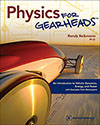|
Now Available! |
Physics for Gearheads
Price: $119.95
|

Adam's Auto Advice - February 25, 2015
Physics for Gearheads Review
Review by James Halderman, author of Automotive Technology - Principles, Diagnosis, and Service among many other technical automotive textbooks.
As an author of 15 automotive college textbooks, it is not often that I am asked to review another automotive book, in this case Physics for Gearheads. However, this title does not compete against any of my titles (visit jameshalderman.com) but instead is designed for the automotive enthusiast who has a technical background and wants the engineering explained as it relates to motorsports. These enthusiasts, who the author calls "gearheads", should have college-level physics to get the most from this title. It is organized and written in such a manner that it can be read or studied as individual topics. The author also suggests that the reader allow time to fully absorb the content before moving on to another chapter. The chapters are organized, not by the parts or systems of a car, but rather by the physics concepts which include:
- Kinematics - (Discussed in Chapters 2 and 3)
- Dynamics - (Discussed in chapters 4 and 6)
- Forces - (Discussed in Chapter 5)
- Angular Dynamics - (Discussed in Chapters 8 and 9)
- Dynamics in a Plane - (Chapters 10 and 11)
- Energy - (Discussed in chapters 12 and 13)
- Power - (Discussed in Chapters 14 and 15)
- Statics and Quasi-Statics - (Discussed in Chapters 16 and 17)
As an author myself, I know how hard it is to organize content and writing into a reasonable readable flow, but this organization in Physics for Gearheads is hard for me to understand. While all of these concepts are associated with motorsports, I would have organized it around the systems of the vehicles such as tires, suspension, drivetrain and then discuss the various physics concept that apply to each area. Regardless of how I would organize the content, I found the book to be very well written and accurately covers the physics associated with all motorsports and racing.
The Interior Design Features
- Examples
- Key Concepts
- Notes
- Major Point
- Cautions
These features help the reader by making the text perfectly clear and helps prevent misunderstandings. However, this text is written in second person (you, we, your, let's etc.) which I think distracts from a technical text where I prefer the use of third person. I doubt few will notice but it does tend to sound as if the author is talking down to the reader at times.
Big Plus of Physics for Gearheads
I loved appendix 2 (pronunciations). Great idea. Who doesn't need help with this once in awhile?
What I Missed Seeing
I missed real world case studies where a vehicle owner wants to know what affect a change in tires size (width or diameter) would have on the acceleration, cornering etc.

Review from and courtesy of www.AdamsAutoAdvice.com - February 25, 2015
http://www.adamsautoadvice.com/physics-for-gearheads-review/
![[B] Bentley Publishers](http://assets1.bentleypublishers.com/images/bentley-logos/bp-banner-234x60-bookblue.jpg)
